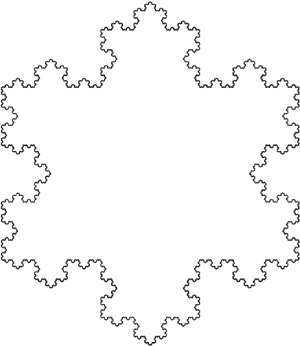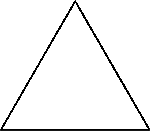 This example is tougher than the Sierpinski gasket. It appears that the snowflake
is not made up of exact copies of itself. So how can we determine the values
for our capacity dimension formula?
This example is tougher than the Sierpinski gasket. It appears that the snowflake
is not made up of exact copies of itself. So how can we determine the values
for our capacity dimension formula? This example is tougher than the Sierpinski gasket. It appears that the snowflake
is not made up of exact copies of itself. So how can we determine the values
for our capacity dimension formula?
This example is tougher than the Sierpinski gasket. It appears that the snowflake
is not made up of exact copies of itself. So how can we determine the values
for our capacity dimension formula?
First we introduce the idea that every part of the snowflake will have the same dimension as the snowflake itself. To conceptualize this, we again turn back to our simple objects. If we take a piece of any size from anywhere along a line, the piece's dimension will still be 1. Similarly, we can take any piece of a square and it will be 2-dimensional, and any chunk taken from a cube will have dimension 3. Keeping in mind that only the line is a part of the snowflake, and not the white space in between, we deduce that if we can determine the dimension of each of the line segments that make up the fractal, then the snowflake itself will have the same dimension.
But how do we determine the capacity dimension of the line segments? Their capacity dimension is not simply 1. Indeed, the Sierpinski gasket is also made up of line segments and we saw that its dimension is closer to 2 than 1. The key to determining the dimension of the line segments is by looking at the grammar that builds the fractal:
|
Specifically, we note that the single transformation rule simply transforms every line into something else. Exactly what does it do to the lines? This is easily seen by looking at the first two iterations of the fractal:



Do you see what has happened? Each line has been transformed into 4 lines. Visually, the middle third of each line has been replaced by two lines that jut out from the figure. We know that the rotation unit is 60 degrees, and that all lines have the same length, thus we can conclude that the length of the two lines that jut out is the same as the length of the piece of the original line that has been removed (equilateral triangles). Thus we have that each line has been transformed into 4 identical lines, each one third the size of the original. In other words, each line has become 4 self-similar copies with 3 for scaling factor! The values we want are P = 4 and S = 3, and thus the dimension of the Koch snowflake turns out to be:

Just as in the case of the Sierpinski gasket, the infinite length (proven briefly below) and zero area of the fractal suggests a dimension between 1 and 2, and the result of our capacity dimension formula gives us just such a value. In addition, it suggests that the snowflake's dimension is less than that of the gasket, and is actually closer to being 1-dimensional than 2-dimensional. It does appear "less infinitely complex" than the gasket, doesn't it?
We let n be the number of iterations performed so far, with n = 0 for the first iteration. At each iteration, all lines are replaced by 4 lines of 1/3 the length. Thus each iteration increases the total length by a factor of 4/3. At n = 0, there are 3 edges, so if the initial line length is 1/3, the length at n = 0 is 1. Thus, at iteration n, the length is (4/3)^n. We take the limit of this:

Because (4/3) > 1, the length increases with n, and thus the Koch snowflake has infinite length. QED